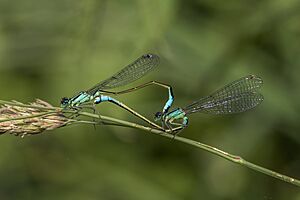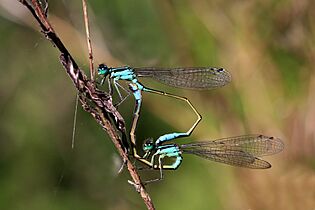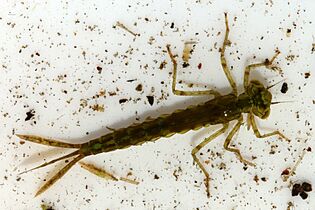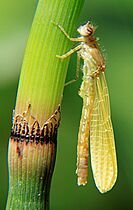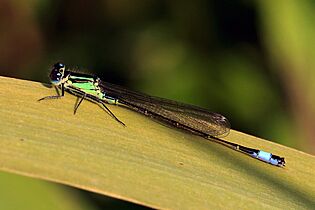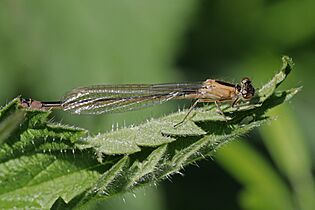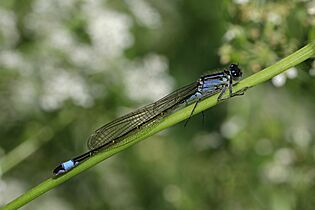Blue-tailed damselfly facts for kids
Quick facts for kids Blue-tailed damselfly |
|
|---|---|
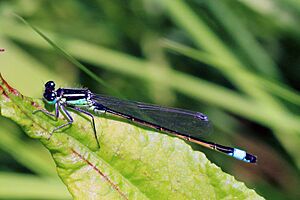 |
|
| Mature male | |
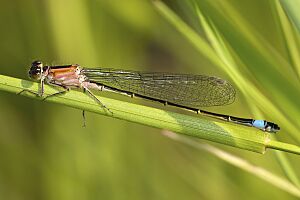 |
|
| Female, form rufescens | |
| Scientific classification | |
| Synonyms | |
|
The blue-tailed damselfly or common bluetail (Ischnura elegans) is a small, colorful insect. It belongs to the damselfly family called Coenagrionidae. These amazing insects are often seen flying near water. They are known for their bright colors and graceful flight.
Contents
Where They Live
Blue-tailed damselflies live in many parts of Europe and the Middle East. They are a very common sight in these areas. You can often spot them near ponds, lakes, and slow-moving rivers.
Their Home Environment
These damselflies like to live in many different watery places. You can find them near still water, like ponds. They also live near slow-moving rivers. Sometimes, they even live in slightly salty or polluted water.
What They Look Like
A blue-tailed damselfly can grow to be about 2.7 to 3.5 centimeters long. Their wingspan is around 3.5 centimeters. The hindwings are usually 1.4 to 2.0 centimeters long.
Male Damselflies
Adult male blue-tailed damselflies have a head and body (thorax) that are blue and black. Their eyes are bright blue. The front wings have a special two-colored spot called a pterostigma. Their long body (abdomen) is mostly black. It has thin pale lines where each segment joins. However, the eighth segment of their abdomen is completely pale blue. When they rest, damselflies hold their wings together over their back. This is different from dragonflies, which rest with their wings spread out flat. Young male damselflies have a greenish color on their body.
Female Damselflies
Female blue-tailed damselflies come in many different colors. Young females might be salmon pink (called form rufescens). Some are violet (form violacea), and others are a pale green. Their color gets darker as they get older. Adult females can be blue, just like the males (form typica). Other adult females might have an olive green body with a brown spot (form infuscans). Some have a pale brown body with a brown spot (form infuscans-obsoleta).
How They Live and Behave
Adult blue-tailed damselflies fly from April until early October. They are skilled hunters. They catch small flying insects while in the air. They use their legs like a basket to scoop up their prey. They also eat insects they find on leaves. Baby damselflies, called nymphs, live in the water. They hunt and eat small water insects or other tiny water creatures.
Mating and Eggs
Sometimes, a male damselfly might try to bother a mating pair. It might even attach itself to the male that is already mating. The female damselfly always lays her eggs on floating parts of plants. She does this by herself, without the male's help.
Amazing Fliers
Blue-tailed damselflies are excellent fliers. They can move each of their four wings in different ways to steer. This helps them fly very well. A recent study showed that they can even fly and catch food if they lose a whole wing!
Female Color Differences
Female damselflies have developed different color forms. This is called polymorphism. These different colors help some females avoid unwanted mating attempts. They do this by looking like males. Females can get their adult colors just a few days after they change from water larvae to their adult forms. These different colored females also have different ways to avoid males.
Finding a Mate
Blue-tailed damselflies have a mating system where males try to find a mate as fast as possible. The male who finds a female first is usually the one who gets to mate.
These damselflies can quickly adjust to their surroundings. This means they face strong natural pressures to adapt. Since this species first came from warm places, their eggs often hatch faster in warmer temperatures. Females also tend to stay near water bodies because that is where they lay their eggs.
Gallery


